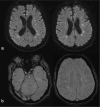Neurologic features in hospitalized patients with COVID-19: a prospective cohort in a catalan hospital
- PMID: 39951175
- PMCID: PMC11920300
- DOI: 10.1007/s10072-025-08031-y
Neurologic features in hospitalized patients with COVID-19: a prospective cohort in a catalan hospital
Abstract
Objectives: To study the prevalence and timing of neurological manifestations, including cognitive involvement, in patients hospitalized for Coronavirus disease 2019 (COVID-19). To analyze the pathogenic mechanisms and any association they have with disease severity.
Methods: Longitudinal cohort study with prospective follow-up of patients who required hospitalization. Patients under 65 who had no pre-existing cognitive impairment and did not require an ICU stay were evaluated 3 and 12 months after discharge using a battery of neuropsychological tests.
Results: Of 205 patients hospitalized for COVID-19, 153 (74.6%) presented with neurological manifestations. The most frequent were myalgia (32.7%), headache (31.7%), dysgeusia (29.2%), and anosmia (24.9%). Patients with more severe illness at the time of hospitalization presented fewer neurological manifestations. Of the 62 patients who underwent neuropsychological examination 3 months after discharge, 22.6% had impaired attention, 19.4% impaired working memory, 16.1% impaired learning and retrieval, 9.7% impaired executive functions, and 8.2% impaired processing speed. Patients with anosmia also presented with more headache (OR 5.45; p < 0.001) and greater risk of working memory impairment (OR 5.87; p 0.03). At follow-up 12 months after hospital discharge, 14.3% of patients still showed impaired attention, 2.4% impaired working memory, 2.5% impaired executive functions, and 2.5% impaired processing speed.
Discussion: Neurological manifestations are common in patients hospitalized for COVID-19 regardless of severity. The high prevalence of anosmia and its association with headache and working memory impairment at 3 months, suggest potential direct or indirect damage to the prefrontal cortex via invasion of the olfactory bulb by COVID-19.
Keywords: COVID-19; Clinical neurology; Cognitive disorders; Neurovirology.
© 2025. The Author(s).
Conflict of interest statement
Declarations. Ethicals approval: The study was approved by the hospital’s ethics committee. Consent informed: Consent was obtained from all study participants before a witness given the circumstances of patient isolation and virus infectivity. Competing interests: The authors have no competing interests to declare that are relevant to the content of this article.
Figures



References
MeSH terms
LinkOut - more resources
Full Text Sources
Medical

